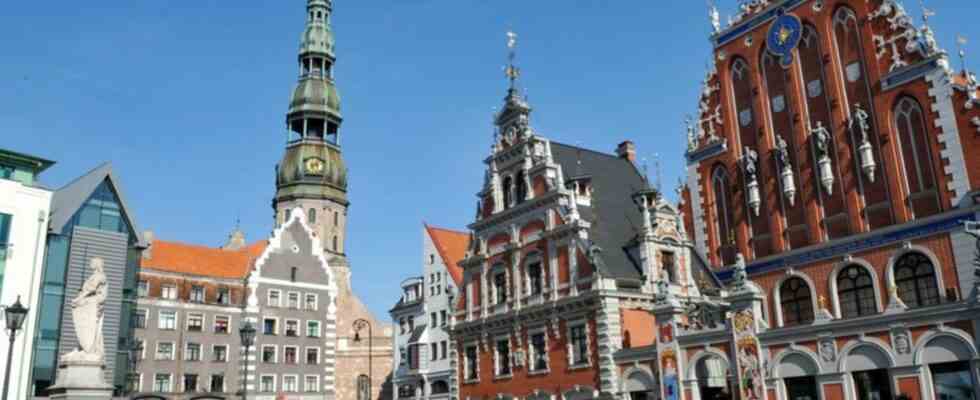Federal President
Steinmeier in Riga at the cradle of the Reformation in the Baltic States
The House of the Blackheads (r.) and St. Peter’s Church (l.) on the Town Hall Square of the Latvian capital Riga. Photo: Uwe Zucchi/dpa-Zentralbild/dpa
© dpa-infocom GmbH
St. Peter’s Church is the tallest church in Riga and dominates the skyline of Latvia’s capital. Now it will be transferred back to the German community. Also present: a distinguished guest from Germany.
Angela Merkel was already at the top – now Frank-Walter Steinmeier wants to do the same and aim high in Riga. To be precise: 70 meters. At this height is the observation deck on the tower of the tallest church in the Latvian capital: St. Peter’s Church.
It offers a beautiful view of the Baltic Sea metropolis. The then Chancellor enjoyed the panoramic view during her visit to Riga in 2010 in bright sunshine. Now the Federal President can also let his gaze wander over the roofs of the old town during his visit this Tuesday.
But Steinmeier did not travel to Riga for tourist reasons for the eleventh time in his long political career as German foreign minister and head of state. More than 75 years after the end of the Second World War, the church is handed over to a joint foundation of the Latvian Evangelical Lutheran Church and the German St. Peter’s Congregation. Together with his Latvian colleague Egils Levits, the Federal President will take part in a thanksgiving service and the official key handover.
“This is great appreciation for us and a sign that we are aware of our common history,” said Stefan Meissner, Chairman of the St. Petrikirche Foundation, the German Press Agency. St. Peter’s Church is an architectural monument of national importance in Latvia. But it also has historical significance for Germany.
Reformation quickly spilled over from Germany to the Baltic States
For it was here that the Reformation in what is today Latvia and beyond in the entire Baltic region began half a century ago – only a few years after Martin Luther’s posting of theses in Wittenberg in 1517. This made Riga one of the first cities outside of Germany where Protestantism spread. This also set decisive impulses for the development of Latvian literature and the educational system. German pastors played a large part in this.
The Reformation ideas were introduced by Pastor Andreas Knöpken (1468-1539). On June 12, 1522, the clergyman from Brandenburg discussed 24 theses he had put forward with followers of the old doctrine in the Petrikirche. A commemorative plaque, which Steinmeier’s predecessor Joachim Gauck unveiled in 2017, has been a reminder of this for a few years now. At that time he was also presented with a facsimile of a historical letter from Luther, who, according to tradition, wrote 17 letters to his followers in the trading and missionary outpost on the Baltic Sea.
500 years later, Lutheranism is the largest denomination in Latvia today – almost 25 percent of the 1.9 million inhabitants of the Baltic EU country profess it. Many believers regularly attend church services in St. Peter’s Church. This should not change in the future either. “We will fill the church with church life and ensure the basic renovation in order to preserve the church for future generations,” emphasized Meissner, who also heads the parish council of the German community.
Ownership creates a redevelopment backlog
The reassignment put an end to decades of public debate over ownership of the 13th-century church. Unlike other church buildings, St. Peter’s Church was not reassigned to a religious organization after Latvia regained independence from the Soviet Union in 1991. Instead, it was entrusted to the city of Riga – pending the passage of a separate law.
But this was a long time coming – and the church, which was also used as a tourist object, museum and event location, remained in the possession of the city administration. According to Latvian media reports, this filled the capital coffers to no small extent. In view of the unclear ownership situation, however, only part of the proceeds went towards maintaining the church. Cracks in walls and floors, damaged roofs, mould, erosion of bricks – the National Monuments Authority’s inspection report from spring last year points to significant shortcomings.
The most important task of the new old owners is therefore the renovation of the sacred building, which has been rebuilt and destroyed several times in its long history and which, with its 123 meter high tower, resembles the main church of St. Catherine in Hamburg. The community can also count on German support: the Bundestag has already approved funds for the preservation and restoration of the Petrikirche.

